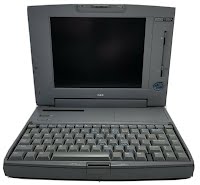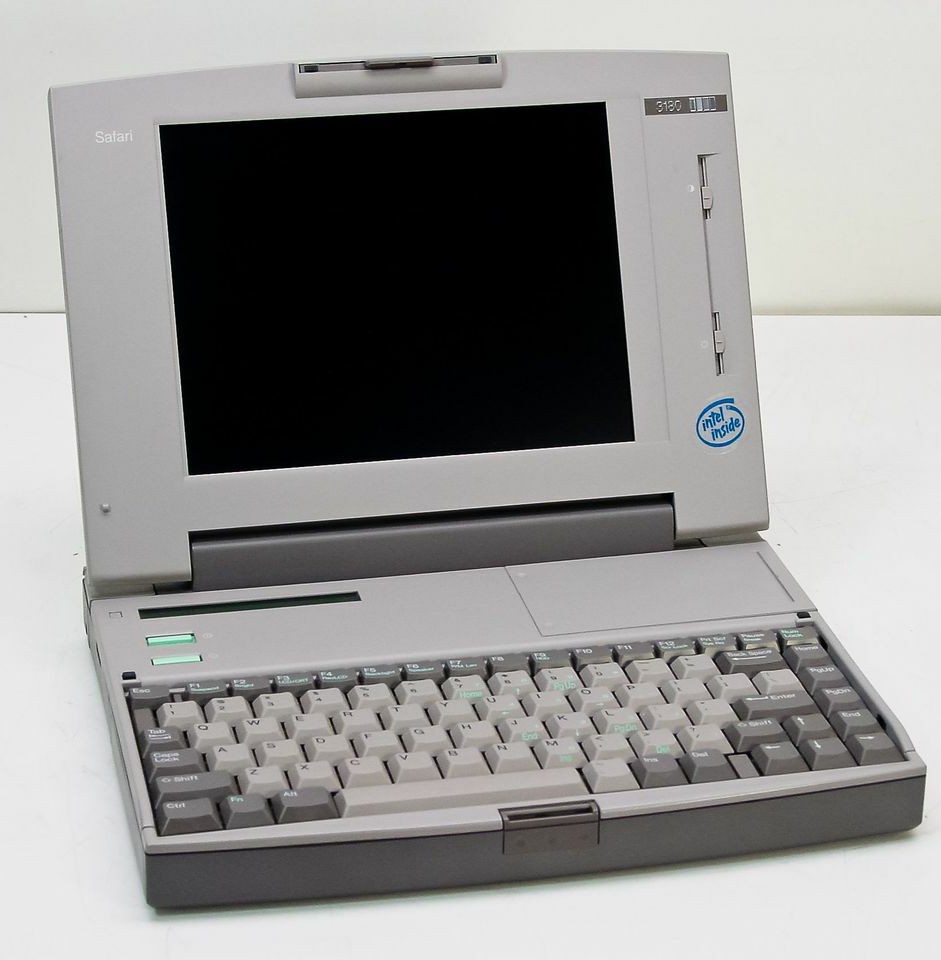

| NEC UltraLite Versa 20/25/33 | ||||||||||||||||||||||||||||||
 The NEC Ultralite Versa was NEC's update to the NEC UltraLite series released in early 1993. These were all Intel 80486 DX SL based laptop computers and were much critically acclaimed for their "desktop level" performance, especially in the area of graphics performance. They came in 20, 25, 33 MHz, and were initially available in Active Matrix Color (C - ie 20C/25C/33C), and STN Monochrome (no designation), but later had touch equivalents released. The one to the left is the base model, a NEC Ultralite Versa 20.
The NEC Ultralite Versa was NEC's update to the NEC UltraLite series released in early 1993. These were all Intel 80486 DX SL based laptop computers and were much critically acclaimed for their "desktop level" performance, especially in the area of graphics performance. They came in 20, 25, 33 MHz, and were initially available in Active Matrix Color (C - ie 20C/25C/33C), and STN Monochrome (no designation), but later had touch equivalents released. The one to the left is the base model, a NEC Ultralite Versa 20.
The NEC UltraLite Versa was considered the "top-of-the-line" portable workstation in NEC's lineup at the time and featured many unique features for the time such as hot-swappable hard disks and batteries, a digital LCD readout, battery life of up to 8 hours (with 2x NiMH Batteries, one in place of the floppy drive), 2x PCMCIA Type II slots, tool-less user upgrades for the hard disk, RAM (3.3V memory cards), and a user-upgradable screen that could be flipped backwards and even hot- swapped using 2 butterfly latches at the back of the computer's case. Model#s were as follows...
THE NEC/AT&T CONNECTION - THE AT&T SAFARI 3180  In 1993, National Cash Register (NCR) was bought out by telephone giant AT&T. AT&T had started selling rebranded Samsung laptops as NCR at that point, but apparently they needed a higher end maker for their top-of-the-line models. So AT&T/NCR looked to NEC to build it, and NEC built just that. The NCR Safari 3180 is basically just a regular NEC UltraLite Versa 33MHz model with different coloring and design.
In 1993, National Cash Register (NCR) was bought out by telephone giant AT&T. AT&T had started selling rebranded Samsung laptops as NCR at that point, but apparently they needed a higher end maker for their top-of-the-line models. So AT&T/NCR looked to NEC to build it, and NEC built just that. The NCR Safari 3180 is basically just a regular NEC UltraLite Versa 33MHz model with different coloring and design.As you can see to the left, the NCR Safari 3180 was 100% identical except the case badges, and the coloring of some parts. On all AT&T Laptops, the screen bezel and keyboard bezel/palmwrest was a lighter shade of gray, and the power/standby buttons had mint colored accents. The logos on the screen were changed, with the logo showing either 3 grayscale squares for Monochrome, or Red/Green/Blue squares for color next to the model number on the label. All stuff previously badged NEC had unique color choices. It seems these came a little later too as they are all 33MHz and they seem to suffer far less issues with cracking than the early Ultralites did. PERFORMANCE, SPECS, AND COMMON INFORMATION IN IT'S DAY The NEC Ultralite Versa was another major "Magazine Darling" of the time, getting glowing reviews in PC Mag at the time. At it's release, it was a real unicorn, but also really expensive, with the base monochrome model in 20MHz with 4MB of RAM and an 80MB HDD costingg over $3000. So not a lot of people bought these. However, they offered desktop-level performance in a laptop package at the time, and paired with the docking station, which cost about $650, were practically a desktop replacement and a really hardcore technology tool. Common Configurations were more varied with this model, I think this is because it seems the Ultralite seemed to sell more individually than it did as a leased Enterprise device. I believe these were most likely C-Suite choices of laptop at first before some less as expensive variants in the E-series came in and companies started to order fleets of these for their portable users. However, it seems the most widely distributed models were the PC-410-1521 model, which was a 8MB UltraLite Versa 25C with a 120MB HDD installed, and came with a 14.4K modem and possibly a LAN card as well (10mbps PCMCIA Type II), as well as a Microsoft Ballpoint mouse in PS/2. However, this model is one of the early ones with the exploding hinges, so I see more destroyed units than I do totally intact ones. The Best model was the PC-430-XXXX version which had the updated plastic and a 33MHZ 486 CPU. The lowest model was the PC-400-1511, which was a Monochrome 4MB model with 80MB HDD and no options - I have seen one on e-bay, I wished I'd nabbed it when It was availiable. Performance, Reliability, Durability in the Common Age The NEC UltraLIte Versa has been the HARDEST computer for me to get ahold of out of all the NEC laptops, even though they are plentiful, people ask too much for r them a lot of the time, especially if working, and another problem is that they are indeed, and rightfully seen as an influental or popular system of the time. Also, most systems have the same 2 problems - craccked right side hinge (active matrix models), and they don't power on. On E-bay as o this writing, there are 2 AT&T 3180s and 1 UltraLIte Versa on their site and all of them are over $50.00 incl shipping, and only one of them is said to be "working" and that one is only partially. It seems the power section was a huge problem with these. COMMON ISSUES WITH USED EXAMPLES The NEC Ultralite Versa is theh most delicate of the Versa models. Common problems are as follows...
|